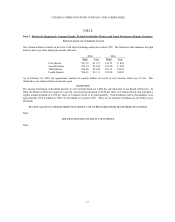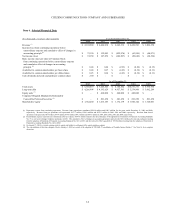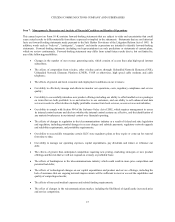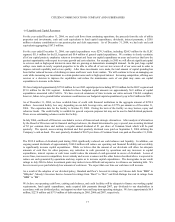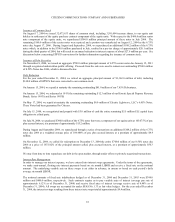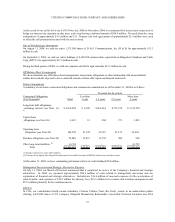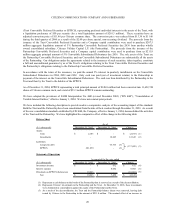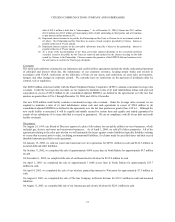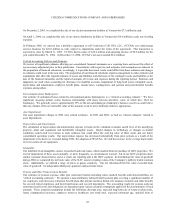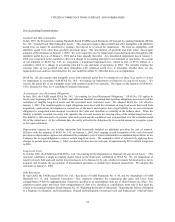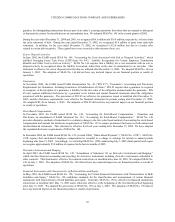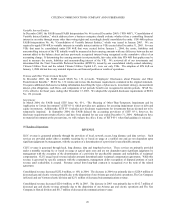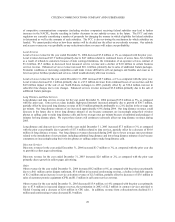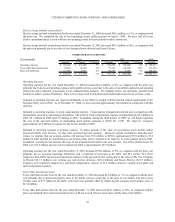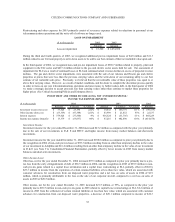Frontier Communications 2004 Annual Report Download - page 24
Download and view the complete annual report
Please find page 24 of the 2004 Frontier Communications annual report below. You can navigate through the pages in the report by either clicking on the pages listed below, or by using the keyword search tool below to find specific information within the annual report.
CITIZENS COMMUNICATIONS COMPANY AND SUBSIDIARIES
22
On December 2, 2003, we completed the sale of our electric transmission facilities in Vermont for $7.3 million in cash.
On April 1, 2004, we completed the sale of our electric distribution facilities in Vermont for $14.0 million in cash, net of selling
expenses.
In February 2005, we entered into a definitive agreement to sell Conference-Call USA, LLC, (CCUSA) our conferencing
services business for $41.0 million in cash, subject to adjustments under the terms of the agreement. This transaction is
expected to close by March 31, 2005. CCUSA had revenues of $24.6 million and operating income of $8.0 million for the
year ended December 31, 2004. At December 31, 2004, CCUSA’s net assets totaled $24.4 million.
Critical Accounting Policies and Estimates
We review all significant estimates affecting our consolidated financial statements on a recurring basis and record the effect of
any necessary adjustment prior to their publication. Uncertainties with respect to such estimates and assumptions are inherent in
the preparation of financial statements; accordingly, it is possible that actual results could differ from those estimates and changes
to estimates could occur in the near term. The preparation of our financial statements requires management to make estimates and
assumptions that affect the reported amounts of assets and liabilities and disclosure of the contingent assets and liabilities at the
date of the financial statements and the reported amounts of revenue and expenses during the reporting period. Estimates and
judgments are used when accounting for allowance for doubtful accounts, impairment of long-lived assets, intangible assets,
depreciation and amortization, employee benefit plans, income taxes, contingencies, and pension and postretirement benefits
expenses among others.
Telecommunications Bankruptcies
Our estimate of anticipated losses related to telecommunications bankruptcies is a “critical accounting estimate.” We have
significant on-going normal course business relationships with many telecom providers, some of which have filed for
bankruptcy. We generally reserve approximately 95% of the net outstanding pre-bankruptcy balances owed to us and believe
that our estimate of the net realizable value of the amounts owed to us by bankrupt entities is appropriate.
Asset Impairment
Our asset impairment charges in 2002 were critical estimates. In 2003 and 2004, we had no “critical estimates” related to
asset impairments.
Depreciation and Amortization
The calculation of depreciation and amortization expense is based on the estimated economic useful lives of the underlying
property, plant and equipment and identifiable intangible assets. Rapid changes in technology or changes in market
conditions could result in revisions to such estimates that could affect the carrying value of these assets and our future
consolidated operating results. Our depreciation expense has decreased substantially from prior periods as a result of the
impairment write-down we recorded during 2002, the adoption of SFAS No. 143 and the increase in the average depreciable
lives for certain of our equipment.
Intangibles
Our indefinite lived intangibles consist of goodwill and trade name, which resulted from the purchase of ILEC properties. We
test for impairment of these assets annually, or more frequently, as circumstances warrant. All of our ILEC properties share
similar economic characteristics and as a result, our reporting unit is the ILEC segment. In determining fair value of goodwill
during 2004 we compared the net book value of the ILEC assets to trading values of the Company’s publicly traded common
stock. Additionally, we utilized a range of prices to gauge sensitivity. Our test determined that fair value exceeded book
value of goodwill. An independent third party appraiser analyzed trade name.
Pension and Other Postretirement Benefits
Our estimates of pension expense, other post retirement benefits including retiree medical benefits and related liabilities are
“critical accounting estimates.” We sponsor a noncontributory defined benefit pension plan covering a significant number of
our employees and other post retirement benefit plans that provide medical, dental, life insurance benefits and other benefits
for covered retired employees and their beneficiaries and covered dependents. The accounting results for pension and post
retirement benefit costs and obligations are dependent upon various actuarial assumptions applied in the determination of such
amounts. These actuarial assumptions include the following: discount rates, expected long-term rate of return on plan assets,
future compensation increases, employee turnover, healthcare cost trend rates, expected retirement age, optional form of



